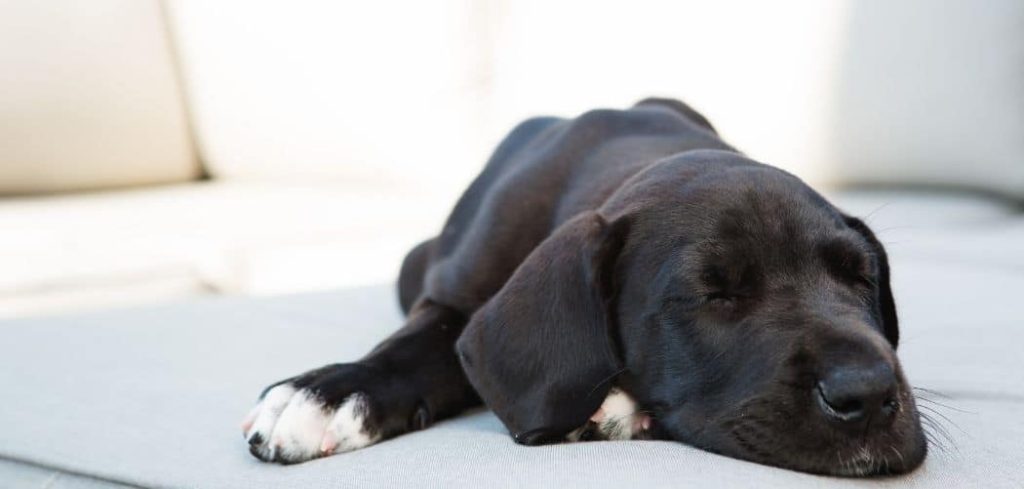It’s alarming to hear your dog panting excessively inside their crate—especially when they should be resting or sleeping.
While some level of panting is normal, heavy or relentless panting in a confined space can indicate stress, or even a deeper medical issue.
We outline the likely causes of a dog panting excessively in the crate, what you can do at home, and when to seek veterinary help.
Table of Contents
Dog Panting Excessively in Crate — Why It Happens
Excessive dog panting in a crate is often a sign of discomfort, anxiety, or a medical condition that becomes more pronounced when your dog is confined. Your dog may be too warm, feeling trapped or panicked, experiencing pain, or dealing with underlying health issues like respiratory distress or heart problems.
Sometimes, it’s a behavioral issue—particularly if the dog is not crate-trained or has separation anxiety. Other times, it can be a sign of an undiagnosed illness that’s exacerbated in stressful situations.

Dog Panting Excessively in Crate: Common Causes
Separation Anxiety
When dogs feel isolated or separated from their owner, they can enter a state of panic. This is particularly common in dogs who haven’t been desensitized to being alone or confined.
In the crate, they may pant excessively, whine, bark, or attempt to escape. Panting caused by anxiety is usually rapid and shallow, often accompanied by drooling or pacing within the crate.
Over time, this can create a negative association with the crate, making it increasingly difficult for the dog to relax.
Read more: Dog Panting Excessively (Here’s why)
Overheating
Crates placed in warm rooms or direct sunlight can easily cause a dog to overheat. Dogs are more susceptible to high temperatures when confined, as they can’t move to a cooler area or pant freely.
Signs include excessive panting, drooling, red gums, and in severe cases, vomiting or collapse. Flat-faced breeds (like Bulldogs or Pugs) and long-haired dogs are especially at risk.
Even a well-ventilated crate can become too hot if there’s no airflow or if bedding retains heat.
Pain or Discomfort
Injury, gastrointestinal distress, or other forms of pain can cause a dog to pant excessively. When confined to a crate, dogs in pain may become more anxious, leading to increased panting and agitation.
You may notice restlessness, a reluctance to lie down, or vocalizing. If the dog normally enjoys crate time but suddenly pants excessively when inside, pain should be ruled out.
Medical Conditions
Respiratory illnesses, heart disease, or hormonal imbalances like Cushing’s disease can cause panting episodes, especially during rest.
Being in a crate may amplify your dog’s discomfort by limiting their movement and response to symptoms. Shallow breathing, coughing, or lethargy along with panting in the crate can point to a medical problem.
Panting that continues even after being let out of the crate warrants a veterinary evaluation.
Lack of Crate Training
If a dog has not been properly crate trained, confinement can trigger anxiety and resistance. This can cause panting, whining, barking, and other stress behaviors.
Crate aversion is common in dogs with negative past experiences (e.g., punishment in the crate) or those who’ve never been introduced to the crate gradually.
Training should focus on creating a positive, low-pressure association with the crate over time.
What to Do If Your Dog Is Panting Excessively in Crate
Start by assessing the environment. Make sure the crate isn’t too warm, overcrowded with blankets, or exposed to direct sunlight. Provide cool, breathable bedding and access to water nearby.
Consider your dog’s crate training status. If your dog shows signs of stress every time they’re crated, revisit crate training with positive reinforcement, starting with short, low-stress sessions.
If overheating is a possibility, use a fan in the room, elevate the crate off warm flooring, or move it to a cooler part of the house.
You can also try calming aids like anxiety wraps, pheromone diffusers, or calming treats, especially for dogs with mild separation anxiety.
Avoid forcing your dog into the crate if they’re showing signs of panic. Reintroduce crate time gradually with treats and praise to rebuild a sense of security.
When to Call or Visit Your Vet
If your dog is panting heavily in the crate and doesn’t stop when let out, that could signal a medical concern such as heart disease, pain, or respiratory distress.
Look for signs like coughing, weakness, vomiting, or collapse—these all point to the need for immediate veterinary care.
Also contact your vet if your dog’s panting in the crate is a new behavior, worsens over time, or occurs alongside other symptoms like loss of appetite or weight loss.
If you’ve addressed temperature, anxiety, and training, and the issue persists, a medical exam is important to rule out serious conditions.
Read more: Dog Panting Excessively After Running (Here’s why)
Key Takeaway
Panting in the crate may be your dog’s way of telling you something’s wrong—whether it’s fear, heat, pain, or illness. Don’t ignore excessive panting, especially if it doesn’t resolve quickly after being let out.
Start with the environment and training, but involve your vet if the behavior continues or seems linked to health concerns.
With the right approach, crate time can be calm and safe for your dog again.
